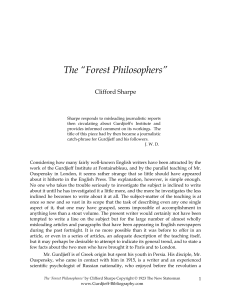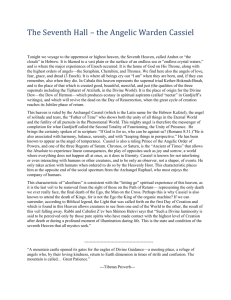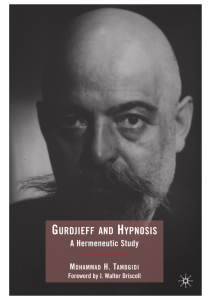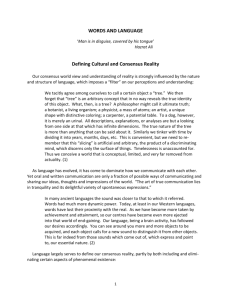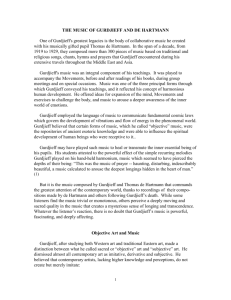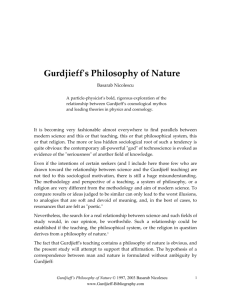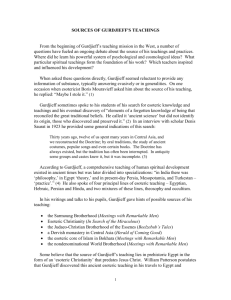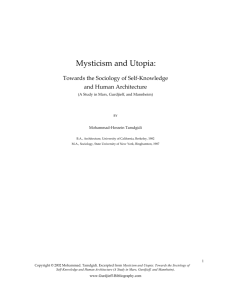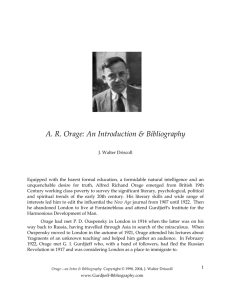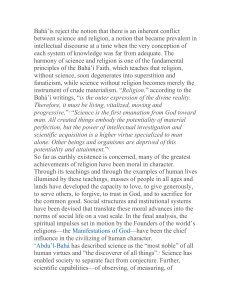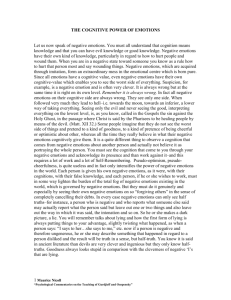Gurdjieff`s Psychological Ideas - Gurdjieff and the Fourth Way: A
advertisement
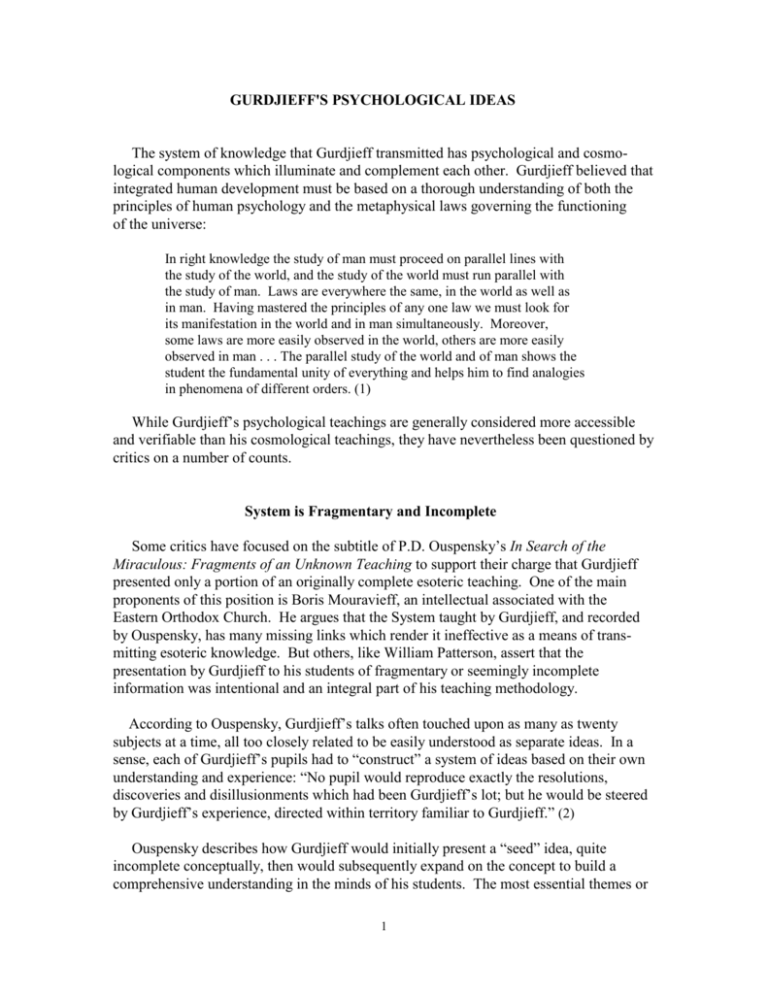
GURDJIEFF'S PSYCHOLOGICAL IDEAS The system of knowledge that Gurdjieff transmitted has psychological and cosmological components which illuminate and complement each other. Gurdjieff believed that integrated human development must be based on a thorough understanding of both the principles of human psychology and the metaphysical laws governing the functioning of the universe: In right knowledge the study of man must proceed on parallel lines with the study of the world, and the study of the world must run parallel with the study of man. Laws are everywhere the same, in the world as well as in man. Having mastered the principles of any one law we must look for its manifestation in the world and in man simultaneously. Moreover, some laws are more easily observed in the world, others are more easily observed in man . . . The parallel study of the world and of man shows the student the fundamental unity of everything and helps him to find analogies in phenomena of different orders. (1) While Gurdjieff’s psychological teachings are generally considered more accessible and verifiable than his cosmological teachings, they have nevertheless been questioned by critics on a number of counts. System is Fragmentary and Incomplete Some critics have focused on the subtitle of P.D. Ouspensky’s In Search of the Miraculous: Fragments of an Unknown Teaching to support their charge that Gurdjieff presented only a portion of an originally complete esoteric teaching. One of the main proponents of this position is Boris Mouravieff, an intellectual associated with the Eastern Orthodox Church. He argues that the System taught by Gurdjieff, and recorded by Ouspensky, has many missing links which render it ineffective as a means of transmitting esoteric knowledge. But others, like William Patterson, assert that the presentation by Gurdjieff to his students of fragmentary or seemingly incomplete information was intentional and an integral part of his teaching methodology. According to Ouspensky, Gurdjieff’s talks often touched upon as many as twenty subjects at a time, all too closely related to be easily understood as separate ideas. In a sense, each of Gurdjieff’s pupils had to “construct” a system of ideas based on their own understanding and experience: “No pupil would reproduce exactly the resolutions, discoveries and disillusionments which had been Gurdjieff’s lot; but he would be steered by Gurdjieff’s experience, directed within territory familiar to Gurdjieff.” (2) Ouspensky describes how Gurdjieff would initially present a “seed” idea, quite incomplete conceptually, then would subsequently expand on the concept to build a comprehensive understanding in the minds of his students. The most essential themes or 1 principles would be withheld from the students initially, and revealed to them only gradually over time. Each student had the responsibility to complete and synthesize the various ideas presented so their understanding would be truly their own. This method has been termed “self-initiation” as each student was required to take the initiative as a seeker to question, inquire and verify the teachings in order to reach a comprehensive understanding. Ouspensky describes the process used by Gurdjieff’s students to make sense of his fragmentary teachings: In the beginning in Russia Mr. Gurdjieff always insisted that it was not a system; it was just fragments and one had to make a system out of them. And he insisted that it should be given in this way . . . it is taught in fragments each of which is on a different scale. You have to put them together and at the same time correct the scale. It is like several geographical maps, each on a different scale, cut into pieces. You have to see which piece fits which, where the scale is very different and where it is less different. This is the only way to study the system. (3) Critics have also questioned whether Gurdjieff’s teachings and methods could actually develop a student’s highest spiritual potential. Gurdjieff did not emphasize the attainment of mystical states of consciousness, and he tended to belittle pupils’ claims of such experiences. For this reason, some have argued that Gurdjieff’s System was incomplete and could not lead seekers to the highest realms of human spiritual development: Perhaps it is true psychologically, spiritually, or existentially that there is “something missing” from the System. If the sights of the pupil are fixed on a very lofty goal, Gurdjieff’s system may seem incomplete in the sense of spiritually incomplete . . . but it is evident that some of his pupils hoped he could lead them further. (4) On the other hand, many other spiritual teachings also downplay the consuming quest for enlightenment through mystical states, emphasizing instead a focus and foundation of self-study and self-knowledge. Pessimistic View of Human Nature One of Gurdjieff’s central ideas was that human beings are ‘asleep,’ living in a world of illusion and imagination, and closed to higher levels of being. In 1915 he told Ouspensky that almost all people are ‘machines’ devoid of free will and incapable of independent decision-making: “All the people you see, all the people you know, all the people you may get to know, are machines, actual machines working solely under the power of external influences.” (5) 2 Critics like scholar Whithall Perry object to Gurdjieff’s emphasis on negative human qualities and his lack of respect for human values: Gurdjieff came to a West of scattered values with a cynical eye that saw clearly -- almost -- the trash that is modern civilization, the mess that is modern man. This in itself is a positive “contribution.” But his vision was negative and destructive . . . For if he was keenly aware of man’s foibles, he suffered a corresponding blindness to man’s virtues. Beelzebub on the surface thus appears as a heavy-handed sneer at the human race. (6) While Gurdjieff’s viewpoint is not unique, with many religions emphasizing humans’ inherent imperfections or separation from God, some critics consider Gurdjieff’s view of the human condition to be unbalanced and overly pessimistic. Boris Mouravieff accuses Gurdjieff of misrepresenting human nature, and of failing to acknowledge the importance of conscience and responsibility, which are central to the Christian doctrine of sin and salvation. William Patterson counters Mouravieff’s criticism by pointing out that Gurdjieff believed that our experience of sin, conscience and repentance are closely linked to our ability to make choices, and that one needs to be “awake” on a spiritual path to be able to make these choices. Those who have not achieved a certain degree of spiritual development are oblivious to these choices and, therefore, the concepts of sin and repentance are irrelevant to them. Gurdjieff’s critics may be misled by his use of terms like ‘asleep’ and ‘redemption,’ which have very specific meanings within the sphere of his teaching. Critics miss Gurdjieff’s subtle understanding of these and other technical terms. The context in which these terms are presented must also be taken into consideration. A student’s understanding of esoteric ideas will change during the course of their development as the many degrees of spiritual knowledge are gradually revealed. The initial understanding of concepts like ‘sin’ and ‘repentance’ may eventually be replaced by a more mature comprehension as higher levels of meaning unfold to the student. Lack of Love One of the most common criticisms of Gurdjieff’s psychological System is the perceived lack of love in the teaching. Gurdjieff’s teachings appeared in many ways the opposite of some traditional spiritual paths, like Bhakti Yoga for example, which emphasize the transformative power of love and devotion. Ouspensky reports that during the Russian phase of Gurdjieff’s teaching many people, including Gurdjieff’s own students, remarked about the absence of love in the Work. Student John Bennett recalls that in the 1920s audience members at Ouspensky’s London lectures would sometimes storm out, protesting: “Mr. Ouspensky, there is no love in your system!” (7) 3 Although Gurdjieff clearly downplayed the more emotional and sentimental expressions of spirituality, the importance of love is by no means absent in his teachings. (8) Gurdjieff’s own writings contain many references to love and reveal a sophisticated understanding which may have easily been misinterpreted. Gurdjieff considered the ‘being-impulse’ of Love to be sacred and advised others to “love everything that breathes.” (9) Gurdjieff made an important distinction between real love and subjective love. Real love is an attribute of the higher self -- genuine, impartial and non-egoistic -- while subjective love is a form of slavery in which one is ruled by internal or external influences. Real love, Gurdjieff claimed, is conscious, not mechanical: “From looking at your neighbour and realizing his true significance, and that he will die, pity and compassion will rise in you for him and finally you will love him.” (10) As a teacher Gurdjieff practised a form of “tough love” in which he challenged and confronted those personality patterns in his students which prevented the emergence of genuine love. Fritz Peters commented after many years of close study with his teacher that “Gurdjieff practised love in a form that is unknown to almost everyone: without limits.” (11) Other students have also acknowledged the debt they owe Gurdjieff for having unlocked for them the power of spiritual love in their lives. They spoke of an impersonal kindness and benevolence, often hidden behind his inexplicable behaviour, that emanated from their teacher: The source of his actions, words and outlook on everything could only be described as something called love. It was not a personal feeling for another but rather one that came from somewhere else . . . it was an opening to a sense of the sacred that he shared with others. (12) In many ways Gurdjieff’s life was a living example of service, compassion and love, as he endeavored to help others attain a higher level of spiritual understanding and being: Control of Negative Emotions One of Gurdjieff’s most controversial and misunderstood ideas was the importance of controlling unpleasant emotions such as anger, fear and irritation. A cornerstone of Gurdjieff’s practical teachings, the management of unpleasant emotions was considered crucial in the process of self-study and self-knowledge: In the sphere of the emotions it is very useful to try to struggle with the habit of giving immediate expression to all one's unpleasant emotions . . . Besides being a very good method for self-observation . . . it is one of the few directions in which a man can change himself or his habits without creating other undesirable habits. Therefore self-observation and self-study must, from the first, be accompanied by the struggle against the expression of unpleasant emotions. (13) 4 Gurdjieff believed that during the expression of strong negative emotions ‘finer substances’ produced by the human organism for the purpose of higher spiritual development are consumed and wasted. He even claimed that the expression of a violent emotion like anger could burn up these substances, leaving one emotionally and spiritually “empty,” possibly permanently. Students of the Work have frequently misinterpreted Gurdjieff’s teaching about negative emotions by adopting the practice of suppressing all emotions. Robin Skynner, a British psychologist and student of the Work, clarifies that Gurdjieff did not advocate a denial of intense feelings, but rather a closer examination and awareness of them: The most common mistake is to confuse his guidance about “not expressing negative emotions” with the concealment, denial, and repression of negative emotions . . . One main purpose of “not expressing negative emotions” in Gurdjieff’s sense, as I now understand it, is to make us more aware of them, to bring us more in touch with the truth about them, with the ultimate aim of transformation of the energy they contain. We have, as it were, to go toward them, to overcome our fear of them and see them clearly for what they are, before any separation from and transformation of them can become possible. (14) Gurdjieff considered negative emotions to be the “raw material” to help his students work on themselves. He frequently provoked students to experience negative emotions so that they would become aware that they carried, and sometimes repressed, these emotions and then could begin to work on them. Gurdjieff believed that the key to controlling their expression of negative emotions was to achieve a state of ‘selfremembering’ in which the student remains fully conscious of himself and his situation and acts freely rather than mechanically. It is through ‘self-remembering’ that negative emotions can be transformed into positive ones. The issue is still the subject of debate in modern psychotherapy circles, where some support the expression of strong emotions to release underlying psychological patterns of repression and denial, while others believe it reinforces a self-centered absorption in unhealthy emotional states. Emphasis on Effort and Struggle Gurdjieff placed a great deal of importance on sustained effort and struggle by his students. He explained that the Work sometimes demanded ‘super-efforts’ which he defined as an effort beyond what is normally required to achieve a given purpose. While working intensively with a small group of students at Essentuki in 1917, Gurdjieff provided a colourful example of a super-effort: 5 Imagine that I have been walking all day and am very tired. The weather is bad, it is raining and cold. In the evening I arrive home. I have walked, perhaps, twenty-five miles. In the house there is supper; it is warm and pleasant. But, instead of sitting down to supper, I go out into the rain again and decide to walk another two miles along the road and then return home. This would be a super-effort. While I was going home it was simply an effort and this does not count. I was on my way home, the cold, hunger, the rain -- all this made me walk. In the other case I walk because I myself decide to do so. This kind of super-effort becomes still more difficult when I do not decide upon it myself but obey a teacher who at an unexpected moment requires from me to make fresh efforts when I have decided that efforts for the day are over. (15) At his Institute at the Château du Prieuré in France, Gurdjieff conceived a number of group projects designed to force his pupils to make super-efforts. One afternoon, Gurdjieff decided to re-seed the lawns of the Château and engaged every able-bodied person in the task. Soon a multitude of students and visitors were working feverishly on dozens of tasks simultaneously. The results were comic: “During this activity, Gurdjieff would march up and down among all the workers, criticizing them individually, goading them on, and helping to contribute a feeling of furious, senseless activity to the whole proceedings.” (16) Observers of the ant-like activity remarked that it appeared Gurdjieff and his students had taken leave of their senses. Some have criticized Gurdjieff’s emphasis on extraordinary effort and sacrifice. Idries Shah argues that mechanical effort is really just a form of conditioning with little value as a spiritual or developmental exercise. He observes that people have been trained to believe that action which requires a physical or financial investment or which involves a sacrifice of time or comfort is a true exercise. But those that require a more subtle change of behavior, like refraining from doing something, can be a more effective expenditure of “effort.” In many Eastern teachings, like Zen Buddhism, Taoism and Advaita Vedanta, effort expended to attain a projected goal is actually considered counter-productive to spiritual growth. Effort which issues from the ego or “I” is viewed as antithetical to a state of unconditioned, effortless awareness: The word “effort” implies intention, the will to achieve some end. But this end is a projection from the past, from memory, and so we miss being present to the moment at hand. It may be accurate to speak of “right attention” . . . but this attention is diametrically opposed to effort in that it is entirely free from direction, motivation and projection. (17) Some of Gurdjieff’s students, in his defense, have stressed that the efforts he required of them were ‘conscious efforts’ based on understanding and self-awareness. Gurdjieff believed that a certain degree of effort must be made by the student at crucial times in their spiritual development, first under the guidance of their teacher until such time as the student can judge for themself what effort to make and when. Effort, when properly 6 focused and expended at the correct stages of a spiritual discipline, will eventually lead to a state of effortless action and awareness as the student matures spiritually. A few decades after Gurdjieff’s death, senior pupil Jeanne de Salzmann, with whom Gurdjieff entrusted the continuation of his spiritual work, introduced a new form of practice which was more passive and receptive than previous exercises and methods: The practice of sitting is difficult to characterize apart from observing that, in accordance with the overall aim of the work, it is not a “form” in and for itself, but is fundamentally a preparation for the inner search within the midst of life. With or without spoken guidance, the aim is ultimately to help individuals search for an embedded presence that sustains the attempt to enter more deeply into an awareness of all the opposing forces constantly moving within the body. Jeanne de Salzmann gave this special work to her older pupils in the way Gurdjieff had given it at the Prieuré. Later, in the 1960s, when groups had become more advanced, she gradually introduced it more broadly. (18) In this group meditation, participants were instructed to remain quietly open to the descent of a spiritual force or “supernal grace” from a higher level of reality: “In regular communal ‘settings’ the highly energized ‘love from above’ professedly entered the pupil’s subtle body through an ‘aperture’ at his crown . . . as he waited with eyes closed in still, sustained, and intensely refined attention.” (19) The nature of this exercise was essentially contrary to Gurdjieff’s admonitions to his students for incessant struggle against ‘sleep’ and an active process of ‘working on oneself’ characterized by self-reliance, effort and constant struggle. While it has been argued that relentless effort and striving may be counter-productive to spiritual growth and lead to diminishing returns (called by some the ‘law of reversed effort’), critics of the practice such as James Moore have ridiculed “the naïve assumption extolled by many that one can simply sit passively in a meditative posture and dream, thinking that miraculous things will automatically happen.” (20) The efficacy and spiritual significance of meditative sitting continues to be debated in Work circles to this day. Substituting Belief Systems Some critics argue that Gurdjieff’s followers turned his System into an alternative world view which merely substituted one set of limiting beliefs for another. Although conceding that a journey out of the ordinary world into a new vision of reality is a fundamental stage along the spiritual path, these critics question whether Gurdjieff’s new order was higher or superior to the world that he had sought to change. 7 In any valid spiritual teaching questions are raised at the outset of study concerning the adequacy of the students’ current understanding of themselves and the universe. Challenging pupils’ assumptions and suggesting other possibilities is a prerequisite to the development of higher perceptions. In many traditional spiritual teachings three stages in the spiritual journey are described: (1) recognition of the trance or ‘sleep’ of ordinary life; (2) destruction of the seeker’s limiting world view by experimenting with new ways of perceiving reality; and (3) reconciliation of the two previous stages through full participation in everyday living based on a higher level of understanding (‘Be in the world, but not of the world’). Although Gurdjieff believed it necessary to move through all three stages of development, many of his pupils became fixed at the second stage and unable to move beyond their conviction of the “truth” of the System. Author James Webb argues that these followers were no better off than before they embarked on Gurdjieff's path: For all the System’s advantages, it is still countering one form of hypnotism with another; and there is no guarantee that the revised world picture has anything to recommend it over the first. It may be that a magical or a religious view of the universe is just as tenable as that of the secondhand car salesman. But it is no more tenable. The verdict here depends upon whether one believes that Gurdjieff took his harmonial vision of the universe as a representation of absolute reality. Many of his followers have thought so -- and have stuck in the alternative universe he proposed to them. (21) Ultimately, each seeker must understand that the language and ideas which express the theoretical side of a spiritual teaching are temporary frameworks and not “holy writ.” A living, organic teaching responds to the needs of particular ‘time, place and people’ by reformulating ideas and practices. Gurdjieff recognized this and made efforts to avoid the traps of conditioning and indoctrination. He deliberately separated from many of his most devoted followers, including senior pupils Alexander de Salzmann, Dr. Leonid Stjoernval and Olga and Thomas de Hartmann, who he believed needed to establish his teachings in their own lives independent of his powerful influence. Commentary Gurdjieff’s psychological ideas are essentially similar to those of many other esoteric teachings. The psycho-spiritual nature of the human being as described by Gurdjieff is echoed in traditions such as Zen Buddhism, Tibetan Buddhism, Taoism, Sufism, Esoteric Christianity, and Advaita Vedanta. (22) Perhaps Gurdjieff’s greatest genius was his ability to present Eastern spiritual ideas and practices in a form useful to the Western seeker. Gurdjieff expressed his psychological System in a style and terminology suitable to 20th century Western culture. He 8 used terms and examples familiar to most students versed in Western psychological concepts, but avoided overt religious or metaphysical references whenever possible. Modern scholars, like psychologist Charles Tart, have praised Gurdjieff as being one of the first to systematically translate Eastern esoteric knowledge for a Western audience, introducing psychological and spiritual formulations that would most effectively aid in the transmission. (23) The ways in which Gurdjieff expressed his ideas were clearly misunderstood and taken out of context by many of his critics. Gurdjieff’s ideas were directed towards seekers of varying levels of development and spiritual maturity; concepts which were intended for beginners may seem simplistic for those at an advanced level. Many of the terms used by Gurdjieff were used metaphorically, not literally. Other terms were endowed with precise technical meaning and were to be interpreted within the context of an esoteric teaching. To be useful and valid an esoteric teaching must be fluid rather than fixed and respond to the needs and potential of each individual pupil. With this in mind, Gurdjieff presented a psychological System that was deliberately incomplete, so that his students would be required to make an active effort to integrate the many ideas into a meaningful gestalt that speaks to their own understanding and level of development. NOTES (1) P.D. Ouspensky In Search of the Miraculous: Fragments of an Unknown Teaching (New York: Harcourt, Brace & World, 1949), p. 122. (2) James Webb The Harmonious Circle: The Lives and Work of G.I. Gurdjieff, P.D. Ouspensky, and Their Followers (Boston: Shambhala, 1987), p. 556. (3) P.D. Ouspensky The Fourth Way (New York: Vintage Books, 1971), pp. 400-401. (4) James Webb The Harmonious Circle: The Lives and Work of G.I. Gurdjieff, P.D. Ouspensky and Their Followers (Boston: Shambhala, 1987), p. 555. (5) P.D. Ouspensky In Search of the Miraculous: Fragments of an Unknown Teaching (New York: Harcourt, Brace & World, 1949), p. 19. (6) Whithall Perry Gurdjieff: In Light of Tradition (Bedfont, Middlesex: Perennial Books, 1978), p. 82. (7) James Webb The Harmonious Circle: The Lives and Work of G.I. Gurdjieff, P.D. Ouspensky, and Their Followers (Boston: Shambhala, 1987), p. 255. 9 (8) See Sophia Wellbeloved “G.I. Gurdjieff: Some References to Love.” Journal of Contemporary Religion vol. 13(3), 1998, pp. 321-2. and A.R. Orage On Love (New York: Samuel Weiser, 1974). (9) Gurdjieff contrasted ordinary subjective love with a more universal from of love that encompassed all life. He conveyed this notion in a talk to his students at the Prieuré in 1923 contained in Views From the Real World: Early Talks of Gurdjieff (New York: E.P. Dutton, 1973, pp. 251-252): Wherever there is life – beginning with plants (for they too have life), animals, in a word wherever life exists, there is love. Each life is a representative of God. Whoever can see the representative will see Him who is represented. Every life is sensitive to love. Even inanimate things such as flowers, which have no consciousness, understand whether you love them or not. (10) G.I. Gurdjieff Views From the Real World: Early Talks of Gurdjieff (New York: E.P. Dutton, 1973), p. 194. (11) Fritz Peters Gurdjieff Remembered (New York: Samuel Weiser, 1971), p. 160. (12) Tcheslaw Tchekhovitch Gurdjieff: A Master in Life (Toronto: Dolmen Meadow Editions, 2006), p. 197. (13) P.D. Ouspensky In Search of the Miraculous: Fragments of an Unknown Teaching (New York: Harcourt, Brace & World, 1949), p. 112. (14) Robyn Skinner “Gurdjieff and Modern Psychology” in Jacob Needleman and George Baker, eds. Gurdjieff: Essays and Reflections on the Man and His Teaching (New York: Continuum, 1996), p. 139. (15) P.D. Ouspensky In Search of the Miraculous: Fragments of an Unknown Teaching (New York: Harcourt, Brace & World, 1949), p. 347. (16) Fritz Peters Boyhood with Gurdjieff (Baltimore: Penguin Books, 1972), p. 67. (17) Jean Klein The Ease of Being (Durham, North Carolina: Acorn Press, 1984), p. 10. (18) Jacob Needleman “Introduction” in The Inner Journey: Views from the Gurdjieff Work ed. Jacob Needleman (Sandpoint, Idaho: Morning Light Press, 2008), p. xx. (19) James Moore “Moveable Feasts: The Gurdjieff Work” Religion Today vol. 9(2), 1994, p. 13. (20) Frank Sinclair Of the Life Aligned (U.S.A.: Xlibris, 2009), pp. 116-117. 10 (21) James Webb The Harmonious Circle: The Lives and Work of G.I. Gurdjieff, P.D. Ouspensky, and Their Followers (Boston: Shambhala, 1987), pp. 550-551. (22) Ravi Ravindra, a scholar and student of the Work, has commented on the essential similarities and differences between the teachings of Gurdjieff and other spiritual traditions in “Gurdjieff Work and the Teaching of Krishna” in Jacob Needleman and George Baker, eds. Gurdjieff: Essays and Reflections on the Man and His Teaching (New York: Continuum, 1996), p. 215. The Sufi mystic Halki describes the universal nature of traditional inner teachings in poetic language: “Numberless waves, lapping and momentarily reflecting the sun – all from the same sea.” (23) Charles Tart Waking Up (Boston: Shambhala, 1986), p. 286. 11
